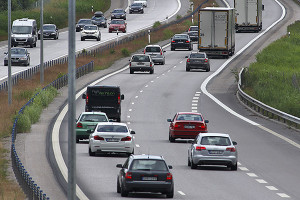Traffic backups can be reduced by new traffic systems in which each vehicle is given an individual speed limit. The major challenge is to get everyone to agree to such a system. VTI is now demonstrating the benefits of new information sources by co-authoring a recently published book.
Ellen Grumert, a research assistant at the Swedish Road and Transport Research Institute (VTI), is a co-author of the book Designing, Developing, and Facilitating Smart Cities: Urban Design to IoT Solution. Ellen’s contribution to the book is based on studies conducted at VTI and Linköping University, and concerns traffic management for smart cities, including individual speed limits. “The purpose of variable speed limits is more efficient travel times and lower emissions, and with this new traffic system you get traffic safety into the bargain as well”, said Grumert.
Shorter Traffic Back-ups
Today we have electronic speed limit signs, but no gathering of data from the traffic. Variable speed monitoring systems could allow vehicles to communicate with one another, either based on information provided via a display indicating a suitable speed for a particular driver, or when the driver turns the system on so that the vehicle adjusts its speed autonomously, without interacting with the driver.
There could be individual speeds for all vehicles, depending on their locations. For example, if traffic becomes backed up, vehicles several kilometres away could receive indications to maintain a lower speed, so that traffic would flow better, saving everyone time.
Certain data can already be obtained, for example, via car GPS systems. It would also be possible to use specific sensors on cars that provide specific data regarding traffic flows, speeds, distances to lead vehicles, vehicle position on the road, and more. This new information would make it possible to improve existing traffic management systems, making them more effective. Speed limits for roads are currently determined using older, simple systems that emphasise safety. For variable speed limits to work, everyone would need to comply with the information distributed by the system. Everyone has to understand that it is possible to avoid a traffic jam if every driver does as the system says. “It is difficult to get everyone to act in accordance with this system, and to get everyone to grasp that they will get where they’re going faster if they do so”, said Grumert.
Measure each vehicle
For a new traffic management system to work, the traffic flows, speed, and density must be determined by processing and analysing the available data. Various traffic models are currently being put to good use. However, no models encompass all aspects of the actual traffic system, which would be a prerequisite for obtaining an accurate and realistic representation.
The currently available traffic models can be supplemented with other data in parallel with the increased development of advanced information and communication technologies for gathering and processing data. An example of such data gathering would be the use of vehicle-mounted sensors that could give a more realistic overview of the traffic. Gathering these data would facilitate a completely different understanding of how trips are made, transport choices, and other travel-related factors. If measurements are made at the individual level as well, the information gathered will be extremely detailed. Such detailed data are a basic precondition for creating a “smart city” in which city systems, such as schools, hospitals and power plants, are interconnected and can communicate.
 Contact:
Contact:
Ellen Grumert, Research Assistant
ellen.grumert@vti.se
VTI, Sweden







Follow us: